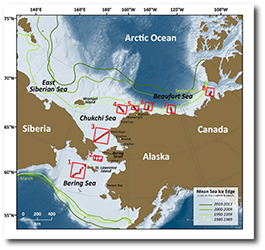 The Distributed Biological Observatory (DBO) – A Change Detection Array in the Pacific Arctic Region, https://www.pmel.noaa.gov/dbo/
The Distributed Biological Observatory (DBO) – A Change Detection Array in the Pacific Arctic Region, https://www.pmel.noaa.gov/dbo/
Funding Agency: NSF Office of Polar Programs, Arctic Observing Network Program
Collaborators: L. Cooper and J. Grebmeier (University of Maryland Center for Environmental Science), and Sue Moore (NMML/NOAA)
Funding Period: 2013-2024
The Pacific sector of the Arctic Ocean is experiencing major reductions in seasonal sea ice extent and increases in sea surface temperatures. One of the key uncertainties in this region is how the marine ecosystem will respond to seasonal shifts in the timing of spring sea ice retreat and/or delays in fall sea ice formation. Variations in upper ocean water hydrography, planktonic production, pelagic-benthic coupling and sediment carbon cycling are all influenced by sea ice and temperature changes. Climate changes are likely to result in shifts in species composition and abundance, northward range expansions, and changes in lower trophic level productivity that can directly cascade and affect the life cycles of higher trophic level organisms. Several regionally critical marine sites in the Pacific Arctic sector that have very high biomass and are focused foraging points for apex predators, have been re-occupied during multiple international cruises. The data documenting the importance of these ecosystem “hotspots” provide a growing marine time-series from the northern Bering Sea to Barrow Canyon at the boundary of the Chukchi and Beaufort seas. Results from these studies show spatial changes in carbon production and export to the sediments as indicated by infaunal community composition and biomass, shifts in sediment grain size on a S-to-N latitudinal gradient, and range extensions for lower trophic levels and further northward migration of higher trophic organisms, such as gray whales. There is also direct evidence of negative impacts on ice dependent species, such as walrus and polar bears. To more systematically track the broad biological response to sea ice retreat and associated environmental change, an international consortium of scientists are developing a “Distributed Biological Observatory” (DBO) that include selected biological measurements at multiple trophic levels coincident with hydrographic measurements and satellite investigations. The DBO currently focuses on five regional biological “hotspot” locations along a latitudinal gradient. Hydrographic transects, providing repeat collections of water parameters over the seasons that are unavailable from single cruises. This network of spatially explicit DBOs is being organized through the Pacific Arctic Group (PAG), a collaborative network endorsed by the International Arctic Science Committee.
